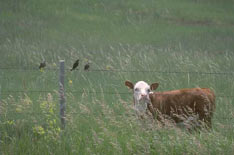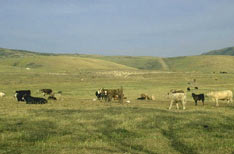|
Unless you've been trapped in a meat locker for the last few weeks, you're no doubt aware that Mad Cow Disease has been detected in the US herd. Given that "bovine spongiform encephalopathy" is tougher on the mouth than one of the blow-torched steaks we get at Billy's House of Meat and Welding Supplies, we'll stick with the short form of the disease name—BSE.
The disease agent responsible for BSE is the prion, and it is unaffected by the heat of cooking or by irradiation.
 So forget about cooking your steak to a cinder before you eat it—that won't be any protection (and would be very upsetting to the Association of Beef Cooking Snobs).
So forget about cooking your steak to a cinder before you eat it—that won't be any protection (and would be very upsetting to the Association of Beef Cooking Snobs).
The key to minimizing your risk from BSE—other than avoiding beef altogether—is to shop for meat that is free of animal byproducts. There are a lot of different labels applied to beef these days, so let's go through what they mean under rules set by the US Department of Agriculture.
- Organic — The organic label does apply to beef and has the backing of a legal standard and a certification system. In the case of beef, organic means that the animal (1) has undergone no genetic modification; (2) was fed grain that was not genetically modified and was free of chemical pesticides, fertilizers, animal byproducts and other adulterants; (3) was not treated with antibiotics, growth hormones, or chemical pesticides. Animals raised for organic meat must also have access to the outdoors, though that doesn't necessarily mean that they spend the majority of their time roaming the open grasslands.
- Free Range — This label is still mostly ungoverned by a legal standard and shouldn't be relied on to determine whether the cow actually spent most of its time on the open plains eating grass or that it ate any particular type of feed. "Free Range" is sometimes also called "free roaming."

- Natural — This is another mostly meaningless term. As the USDA puts it: "All fresh meat qualifies as natural." Meat labeled "natural" (1) cannot contain any artificial flavor or flavoring, coloring ingredient, chemical preservative, or any other artificial or synthetic ingredient; and (2) can only be minimally processed (ground, for example). The USDA requires that meat packages labeled "natural" also include a statement clarifying the use of the term (such as "no added coloring"). In any event, animal byproducts are not specifically prohibited in the feed of cows raised for "natural" beef (though some beef labeled natural may indeed be free of animal byproducts).
- Grass Fed — You'd think that any package of beef labeled "Grass Fed" would mean that the cow ate only grass. But given that all cows eat grass at least in the early stages of their lives, shady dealers could legally apply the "Grass Fed" label to beef from normal feed-lot cattle. This makes it necessary for you to ensure the label says "100% Grass Fed," "Grass Fed Only" or something similar that does not leave any loopholes. Beef raised only on grass may be slightly less tender than "normal" beef, but it has less overall fat, less saturated fat, higher vitamin A content, and more of the omega-3 fatty acids that help maintain healthy cells in your body. Beef that is 100% grass-fed may or may not be organic—all requirements under the organic standard would still have to be met for "100% grass fed" beef to be labeled organic.
- No Antibiotics/No Hormones — Beef with either of these labels must be from a cow that was raised without the use of antibiotics or synthetic hormones over its entire lifetime. While both of these characteristics are desirable in your package of beef, neither has any bearing on BSE.
- No Animal Byproducts — The regulations behind this label are not as strong as for the organic standard, but it's reasonable to assume that the label means what it says, that no animal byproducts were used in the feed of the cow(s).
- Irradiation — Meat that has been irradiated to reduce bacteria levels must be labeled "Treated by Irradiation" or "Treated with Radiation." However, the irradiation levels used on beef do not deactivate the BSE disease agent.
- Prime, Choice, and Select — These USDA grades are a subjective measure of quality and imply nothing about how the cow was raised or whether it's free of BSE.
Well, that's a lot of things to remember, so here are the three labels you really want to look for when you shop for beef: (a) Organic, (b) 100% Grass Fed, and/or (c) No Animal Byproducts.
 Beef with any one of these labels is virtually guaranteed to be free of BSE problems. Cows raised under the standards required for the organic and 100% grass fed labels yield environmental benefits too (compared to regular beef production).
Beef with any one of these labels is virtually guaranteed to be free of BSE problems. Cows raised under the standards required for the organic and 100% grass fed labels yield environmental benefits too (compared to regular beef production).
Remember that we're not just talking about steaks and burgers as a potential source of BSE exposure. Processed beef products, including beef hotdogs, sausage, and meat sauce, also have the potential to contain BSE-contaminated beef. Granted, it is unlikely there would be such a problem, but since beef is available that has been raised in a way that virtually eliminates any BSE possibilities, why take any chance? And if the thought of eating ANY beef these days make you nearly have a cow, try soy-based beef alternatives—they're surprisingly tasty and beef-like these days.
Now that you're armed with the info you need to make smart choices about beef, what else can you do? Tell the USDA to (1) ban the feeding of slaughterhouse waste to livestock, and (2) test ALL slaughtered cows for BSE, not just a small percentage. You might also mention that the beef industry, not taxpayers, should absorb any cost associated with these actions. To email USDA, click here.
Related Grinning Planet articles:
In early December, 2003—just before Mad Cow Disease was found in the US—we published articles on animal byproducts in cattle feed and how such cattle-feeding practices relate to Mad Cow Disease.
|


